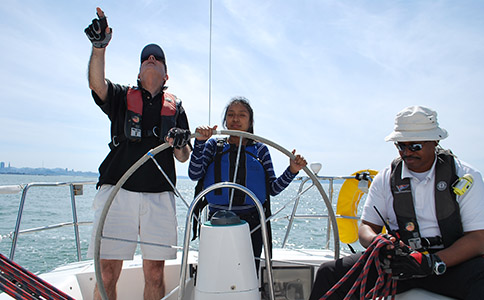During the past two months in my role as an instructor trainer for US Sailing, Iíve conducted two instructor evaluation courses. I thought it might be interesting for me to explain just what potential instructors go through in order to teach sailing for the US Sailing Association.

In order to teach students how to sail, US Sailing requires extensive training and instructor candidates must undergo a three-day evaluation before being certified. Photo by Joel Williams
By Captain Ray
Published: November, 2014
During the past two months in my role as an instructor trainer for US Sailing, I’ve conducted two instructor evaluation courses. I thought it might be interesting for me to explain just what potential instructors go through in order to teach sailing for the US Sailing Association.
There is a hierarchy of certification levels for both students and instructors. According to US Sailing’s Student Certification Standards:
“The Basic Keelboat graduate will have successfully demonstrated the ability to responsibly skipper and crew a simple daysailing keelboat in familiar waters in light to moderate wind and sea conditions.”
In order to teach students at this introductory level, an instructor candidate (IC) must pass the entry-level instructor certification, a US Sailing Basic Keelboat Instructor Course. In order to attend, the ICs must demonstrate their ability to swim and obtain an online certificate from the National Association of State Boating Law Administrators (NASBLA). Then, the three-day evaluation consists of several written tests, a knot-tying and line-handling examination, a single-handed sailing test and two classroom presentations.
The single-handed sailing test requires an IC to perform all of the normal sailing maneuvers—tacking and gybing, heaving to, reefing, sailing off of and returning to a dock or a mooring, and different methods of overboard rescues. All of this must be performed to a role-model standard—i.e., don’t do things you don’t want your students to see!—ideally with grace and confidence.
At the end of each IC’s classroom presentation the entire group will discuss the IC’s performance. During these discussions the instructor trainer is looking to see what type of feedback each candidate provides. Is it accurate? Is negative feedback delivered kindly? Are the positive as well as the negative aspects of the presentation noted?
The second course I ran this autumn was a US Sailing Cruising Instructor Course. This course allowed those instructors who pass to teach and issue certifications for larger, more complex boats. Again quoting from the US Sailing Student Certification Standards:
“The Bareboat Cruising graduate will have successfully demonstrated the ability to skipper and crew an inboard powered sailboat within sight of land and bring it safely to anchor during daylight hours.”
This course does not include any classroom time. It has instead a two-night, three-day liveaboard format, where an IC’s sailing, motoring, seamanship, judgment and interpersonal skills are observed and evaluated.
In order to be examined at this level, an IC must first be a US Sailing Basic Keelboat Instructor. Additionally, because these vessels have motors and the students are paying (and are therefore considered ‘passengers’ by the U.S. Coast Guard), a Coast Guard license is required.
A Coast Guard license is not just a formality. At a minimum, in order to receive a license from the Coast Guard, you must have served on a vessel for at least 360 days (plus an additional 180 days if you want to be licensed to operate sailboats), endure several hours of written tests, have a physical exam and a drug test and pay several hundred dollars in fees.
Both of these instructor courses can be rigorous, challenging and quite tiring. Not everyone passes. However, in addition to pass and fail, there are two other possible outcomes: a Plan of Completion (POC) and Plan of Improvement (POI).
A POC is issued when weather conditions—typically no wind (usually not a problem on San Francisco Bay)—prevent the ICs from demonstrating the necessary skills. A POI is issued to an IC that did not meet the standards in one or two areas. This is someone that US Sailing wants to encourage to practice and improve, then return and turn the POI into a pass.
Ray Wichmann, is a US SAILING-certified Ocean Passagemaking Instructor, a US SAILING Master Instructor Trainer, and a member of US SAILING’s National Faculty. He holds a 100-Ton Master’s License, was a charter skipper in Hawai’i for 15 years, and has sailed on both coasts of the United States, in Mexico, the Caribbean and Greece. He is presently employed as the Master Instructor at OCSC Sailing in the Berkeley Marina.

